I’ve ridden the CTA all my life – long enough to remember when you could open the windows, and there were “A” and “B” runs. I’ve seen weird stuff – shell games, theatrical panhandlers, and even a sheepish pickpocket I was able to talk into returning my phone.
But I’ve never seen the level and frequency of antisocial behavior I’ve seen since the start of the COIVD-19 pandemic, especially on the 'L' at night. I’ve never witnessed so much threatening behavior, breathed so much secondhand smoke, seen such unsanitary conditions, and experienced so much general disorder.
Fellow CTA riders report similar stories – one friend said she actually got off the 'L' to call for a ride home because she felt unsafe.
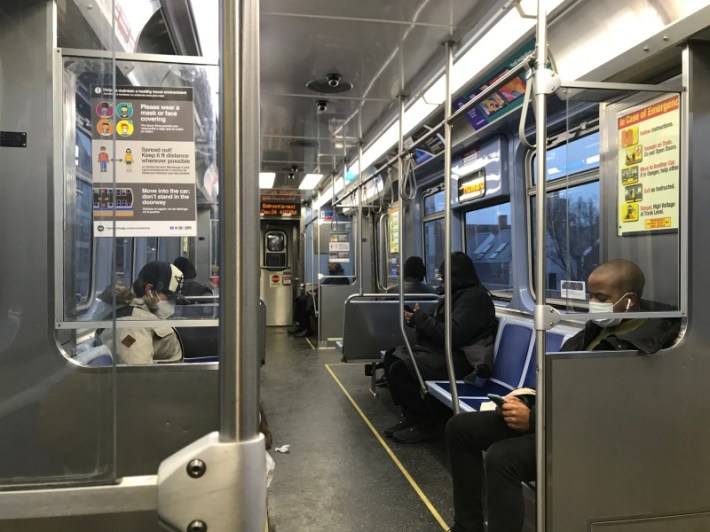
Challenges on the CTA
Data backs up perceptions that the system has gotten less safe during the COVID, when ridership has plunged, meaning fewer "eyes in the cars," and many residents have been experiencing economic and mental health crises. A Chicago Tribune analysis found that the crime rate on 'L' trains and platforms more than doubled in 2020 compared to the previous year. In the past year there have been multiple murders on trains and buses, and an epidemic of attacks on CTA employees and stabbing cases, intensifying calls to improve safety.
In addition to realistic concerns about personal safety, there's also the issue that conditions on trains seem to have gotten less healthy, less sanitary, and more unpleasant in the past two years.
Last week took the biscuit. After a Civic Orchestra concert, I went to the Clark/Lake station to catch the Blue Line. There was a group of people interacting loudly and belligerently getting on one car. Concerned that there might be a fight, I went to the next car and pulled up short. Just inside the door was a large pile of human excrement.
It was the last car on the train, and it was too late to dash for another one. I went to the second door, huddled in my seat, and tried to focus on my book. But the mess was tough to un-see. Things got worse when the train had a problem at another stop and stood for 10 minutes with the doors open. So now the car was freezing AND stinky.
I’m a dedicated transit rider – I’ll put up with just about anything to avoid driving. I've previously written about the need to be empathetic towards unhoused people and individuals with mental illness on the CTA. Last week's incident is not going to stop me from riding the L.
But I wondered what I would have thought if I was visiting from Elmhurst or Omaha, eager to show the kids a world-class city. I’d never take the 'L' again, and tell friends to avoid it.
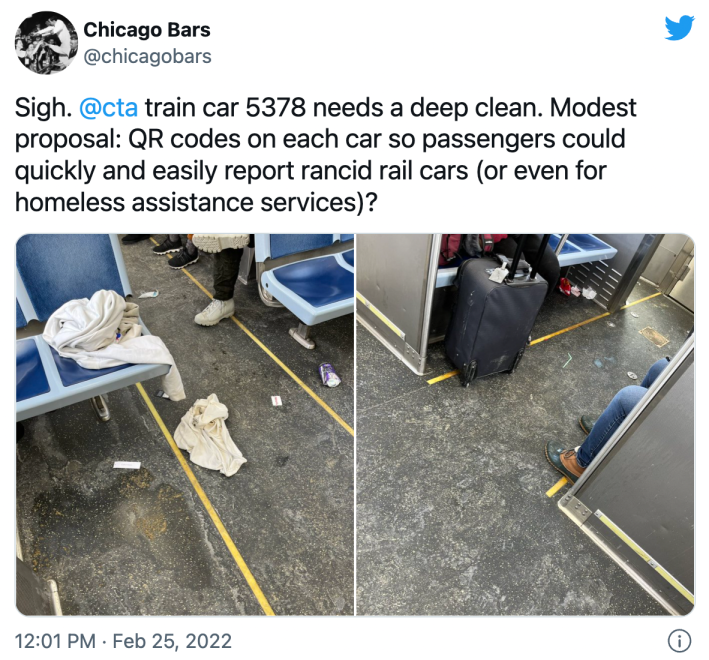
Worse, if the CTA truly becomes a mode of last resort for local residents – with more affluent Chicagoans opting to ride in private cars, taxis, and ride-hail vehicles instead – there's going to be a vicious cycle of falling ridership and revenue, and service cuts and/or fare hikes, commonly known as a "transit death spiral," which will make crashes, pollution, and bus-slowing traffic jams worse. That won't help anyone, least of all low-income and working-class residents who depend on transit to get around.
During the first full month of the pandemic, in April 2020, ridership on the CTA plunged by 85 percent, as people who could do so worked from home. Advocates for people experiencing homelessness saw an increase of people sheltering on emptier trains. The advocates cited Chicago's failure to adequately address its affordable housing crisis, and fear of COVID spread in shelters, as possible causes.
Ridership has since climbed back to 800,000 on an average weekday, nearly double the ridership in February 2021, said CTA spokesman Brian Steele. This is still well below pre-pandemic levels of 1.6 million a day, but Steele said he anticipates more riders returning as workers start coming back to the office and normal activities, like music festivals, resume.
Asked about the ongoing troubles on the system, Steele said the CTA recognizes that homelessness is a “larger societal issue, that sometimes can impact the customer experience on trains and buses. We are committed to addressing the issue in a compassionate and respectful way, while providing a safe and comfortable experience for all riders.” Steele said the CTA works with the city of Chicago and social service providers, including the Night Ministry, to perform outreach on the CTA to people experiencing homelessness. This can include offering to connect unhoused individuals with shelters and offering masks, clothes, food, and personal hygiene items.
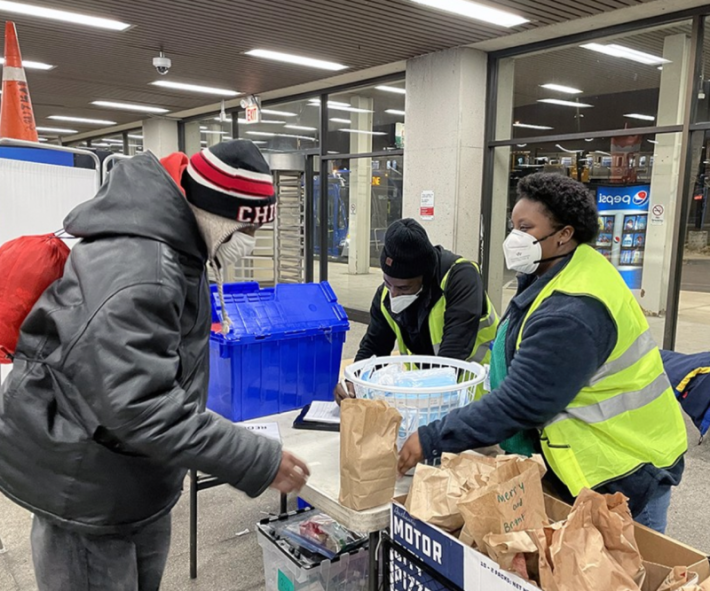
The number of complaints about unhoused individuals on the CTA trains and buses totaled 117 between October 2021 and January 2022, compared to 120 during the same period in 2020-2021 and 205 in the pre-pandemic period in 2019-2020, Steele said. However, the higher number of complaints pre-pandemic may just reflect the fact that there were many more people riding transit at that time.
People simply using the CTA as an emergency shelter, especially in frigid weather, is not the main problem. Someone sleeping stretched across several seats (which is enabled by the aisle-facing bench seats on newer 5000 Series 'L' cars) is inconvenient, but isn’t threatening.
However, second-hand smoke on a closed car is a health hazard, especially for people with respiratory issues. And outright criminal behavior, like threats of violence, is scary for riders and workers. What else can the CTA do to make residents feel comfortable about getting back on transit, prevent violent crime and get troubled people the help they need, compassionately and without increasing the risk of security personnel's interactions with the public escalating to violence?
BART's Transit Ambassadors and special engagement teams
One possible solution is something like what’s being tried on the San Francisco Bay Area's BART system, Transit Ambassadors. This strategy has previously been discussed on Streetsblog Chicago, and is endorsed by Keith Hill, head of the CTA bus drivers’ union. Started two years ago by the San Francisco-Bay Area Rapid Transit Police Department, the program deploys uniformed, unarmed civilians with training in conflict resolution and avoiding racial bias. They provide an authority figure presence on the system, not unlike CTA train conductors, a position that was eliminated in 1998 to save money.
The Transit Ambassadors pass out masks, determine if someone needs help and call for police backup when needed. However, the program seems to reduce the need for officers to be involved in addressing problems on trains. Out of 12,000 "educational interactions" by the ambassadors with the public on BART in the first year of the program, police were only called in 132 cases, or 1.1 percent of the time. In December the CTA has said it was monitoring the BART program, but had no plans to pilot a similar initiative here.
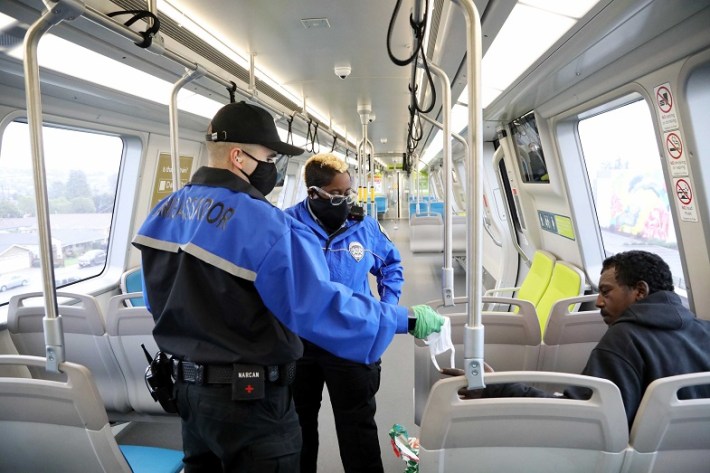
Last November, BART Police added a new program, which uses five, three-person “special engagement teams,” consisting of an armed police officer and two civilians with backgrounds in social work, according to deputy police chief Angela Averiett. She said teams are strategically deployed throughout the BART system to more quickly respond to service calls.
Averiett noted that while the ambassadors act as “eyes and ears on the system” and have been highly successful, they lack specialized training in social work. “We decided we needed to take it a step further and create this other position,” she said.
One goal is to minimize the amount of force needed to respond to problems, Averiett said. “I’m really proud of the work our teams are able to do. They’ve helped some people get off the street. They helped rescue a four-year-old child who was with her mother who was suffering a mental health break. Those are the kinds of things that measure the success of the program.”
Though the BART system sees much less ridership than the CTA, with about 125,000 daily riders now compared to 400,000 pre-pandemic, both the ambassador and special engagement team programs have been very busy, said BART spokesperson Christopher Filippi. In January, ambassadors and SET conducted 1,310 welfare checks, resulting in 89 instances where staff attempted to connect people in crisis with support services, he said. In the first nine days of February, the teams made 361 welfare checks, resulting in 77 outreach contacts. According to Filippi, the contact rate has gone up each month since the initiative started, and Averiett said more hires are planned.
New York's crackdown on unhoused people
On the other coast, New York City has seen renewed demands to improve safety on the subway in the wake of the murder of Michelle Go, 40, last month. Go, who was of Asian descent, was allegedly pushed onto the Times Square station tracks by an unhoused man who had been previously diagnosed with schizophrenia, part of a wave of attacks on Asian Americans during the pandemic.
Chicago saw a similar case last October, when a man who reportedly had mental health issues allegedly attacked a senior who was in town for the marathon, repeatedly punching her until she fell onto the Cermak Green Line station tracks. She survived, but with serious injuries.
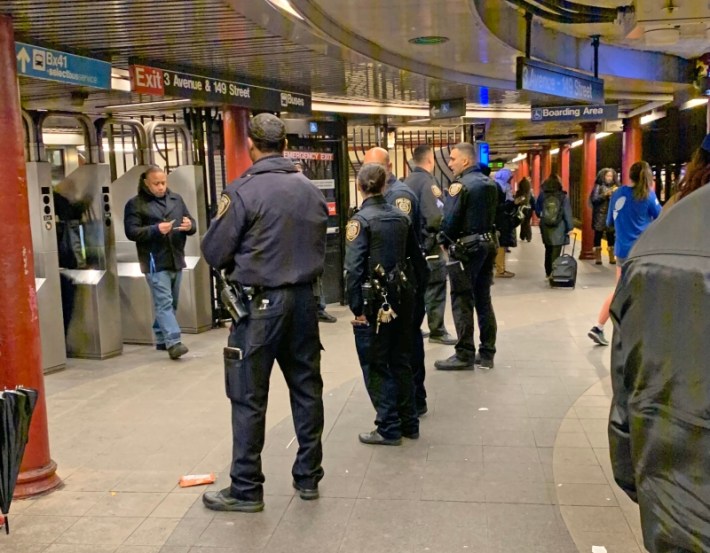
Earlier this month, New York City mayor Eric Adams and New York governor Kathy Hochul announced a plan to deploy police officers and mental health workers in the city’s subway, pledging to remove more than 1,000 unhoused people who regularly shelter on trains. There’s now a zero-tolerance policy for people sleeping, littering and committing other unruly behavior, the New York Times reported. Mental-health professionals will have the power to order hospitalizations of those who are deemed a danger to themselves and others.
While some have applauded this get-tough program. "Chicago needs the same kind of safety plan for the CTA that NYC now has for their subway system, and we need it like yesterday," tweeted one Streetsblog reader.
However, others have argued that it's inhumane to force people experiencing homelessness out of the system without providing them with another option for shelter. "I can't go nowhere now," an unhoused man who'd been ticketed and escorted out of the NYC subway told ABC New York. "What are you talking about, pay a summons? You're gonna give me a summons for being homeless? For real? I don't want to live like this. Who wants to live like this?"
University of Illinois at Chicago transportation expert Dr. Kate Lowe tweeted that she takes issue with how "arrest-heavy (for minor infractions) and police-centric" the New York approach is. "I'm not arguing against safety, mental health, and housing interventions, but am deeply troubled [with] NYC as the model."
Low noted that, according to the ABC report, so far in 2022, arrests on the MTA have spiked by 74 percent, and summonses have increased by 17 percent. By far the most commonly enforced offense has been fare evasion, followed by smoking, drinking alcohol, blocking multiple seats, and urinating in the system.
Meanwhile, warmer weather is coming to Chicago, and complaints about people using the CTA for shelter rather than transportation tend to go down when there are more outdoor options. Also, as society continues to reopen and more people return to trains and buses, that may help deter criminal activity and other truly problematic behavior like smoking, since there will be more people to witness it.
So, here’s hoping things get better and soon. The current U.S. pedestrian fatality epidemic and the advance of destructive climate change means that transit is more crucial than ever for getting cars off the road. Now is not the time for the nation’s second-largest public transit system to go backwards, with conditions that scare people away from using buses and trains.





